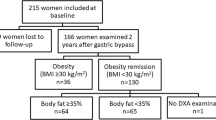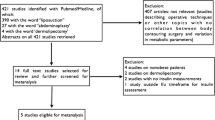Abstract
Background
Abdominal fat (both visceral and subcutaneous) accumulation is associated with an increased risk of developing insulin resistance. The latter stands as the basis upon which diabetes, hypertension, and atherogenic dyslipidemia tend to build up. Hence, abdominal liposuction (AL) could theoretically hold metabolic benefits. We undertook the present study to assess the effects of AL on carbohydrate and lipid metabolism.
Methods
This is a prospective study including 20 healthy volunteers (M2/F18) aged 39.6 ± 7.7 years old (24–52), body mass index (BMI) = 25.3 ± 4.7 kg/m2 (19.8–36) who underwent AL. Before and 4 months after AL, we measured glucose and insulin concentrations, HOMA index [glucose (mM) × IRI (μUI/l)/22.5], free fatty acids (FFA), glycerol, total cholesterol and triglycerides, high-density lipoprotein (HDL)-cholesterol (HDL-c), low-density lipoprotein (LDL)-cholesterol (LDL-c), very low-density lipoprotein (VLDL)-cholesterol (VLDL-c) and apolipoproteins (apo) B, AI and AII, adiponectin (Adp), and ultra-sensitive C-reactive protein (CRP).
Results
Lipo-aspirate averaged 5.494 ± 5.297 cc (600–19.000). Weight, BMI, and waist circumference decreased significantly 4 months after surgery by 4.6, 4.6 and 5.9%, respectively. There were significant decrements in FFA (−35%, p < 0.0001), glycerol (−63%, p < 0.0005), VLDL-c (−15.2%; p < 0.001), and triglycerides (−21.3%, p < 0.002), an increase in HDL-c (+10%, p < 0.03), Apo AI (+10.1%, p < 0.02), and Apo AII (+11.8%, p < 0.001). Total cholesterol, LDL-c, ApoB, and the LDL-c/ApoB ratio raised by +15% (p < 0.0005), +27.3% (p < 0.000), +15.1% (p < 0.008) and +2.76% (p < 0.008), respectively. Glucose, insulin, the HOMA index, Adp, and CRP were not significantly altered after AL.
Conclusion
AL in healthy normal weight or slightly overweight subjects improves the major lipoprotein components of obesity-associated dyslipidemia. This improvement occurs independent of insulin sensitivity.

Similar content being viewed by others

References
Nieves DJ, Cnop M, Retzlaff B, Walden CE, Brunzell JD, Knopp RH, Kahn SE. The atherogenic lipoprotein profile associated with obesity and insulin resistance is largely attributable to intra-abdominal fat. Diabetes. 2003;52:172–9.
Taskinen MR. Diabetic dyslipidaemia: from basic research to clinical practice. Diabetologia. 2003;46:733–49.
Sparks JD, Sparks CE. Insulin regulation of triacylglycerol-rich lipoprotein synthesis and secretion. Biochem Biophys Acta. 1994;1215:9–32.
Lewis GF, Uffelman KD, Szeto LW, Weller B, Steiner G. Interaction between free fatty acids and insulin in the acute control of very low density lipoprotein production in humans. J Clin Invest. 1995;95:158–66.
Burnett JR, Barrett PH, Vicini P, Miller DB, Telford DE, Kleinstiver SJ, Huff MW. The HMG-CoA reductase inhibitor atorvastatin increases the fractional clearance rate of postprandial triglyceride-rich lipoproteins in miniature pigs. Arterioscler Thromb Vasc Biol. 1998;18:1906–14.
Hamsten A, Silveira A, Boquist S, Tang R, Bond MG, de Faire U, et al. The apolipoprotein CI content of triglyceride-rich lipoproteins independently predicts early atherosclerosis in healthy middle-aged men. J Am Coll Cardiol. 2005;45:1013–7.
Kissebah AH, Videlingum N, Murray R, Evans DJ, Hartz AJ, Kalkhoff RK, et al. Relation of body fat distribution to metabolic complications of obesity. J Clin Endocrinol Metab. 1982;54:254–60.
Cnop M, Landchild MJ, Vidal J, Havel PJ, Knowles NG, Carr DR, et al. The concurrent accumulation of intra-abdominal and subcutaneous fat explains the association between insulin resistance and plasma leptin concentrations: distinct metabolic effects of two fat compartments. Diabetes. 2002;51:1005–15.
Wajchenberg BL. Subcutaneous and visceral adipose tissue: their relation to the metabolic syndrome. Endocr Rev. 2000;21:697–738.
Freedland ES. Role of a critical visceral adipose tissue threshold (CVATT) in metabolic syndrome: implications for controlling dietary carbohydrates: a review. Nutr Metab (Lond). 2004;1:12.
Lambert EV, Hudson DA, Bloch CE, Koeslag JH. Metabolic response to localized surgical fat removal in nonobese women. Aesthet Plast Surg. 1991;15:105–10.
Carr DB, Utzschneider KM, Hull RL, Kodama K, Retzlaff BM, Brunzell JD, et al. Intra-abdominal fat is a major determinant of the National Cholesterol Education Program Adult Treatment Panel III criteria for the metabolic syndrome. Diabetes. 2004;53:2087–94.
Jensen MD, Johnson CM. Contribution of leg and splanchnic free fatty acid (FFA) kinetics to postabsorptive FFA flux in men and women. Metabolism. 1996;45:662–6.
Abate N, Garg A, Peshock RM, Stray-Gundersen J, Grundy SM. Relationships of generalized and regional adiposity to insulin sensitivity in men. J Clin Invest. 1995;96:88–98.
Rendell M, Hulthen UL, Tornquist C, Groop L, Mattiasson I. Relationship between abdominal fat compartments and glucose and lipid metabolism in early postmenopausal women. J Clin Endocrinol Metab. 2001;86:744–9.
Matarasso A, Hutchinson OH. Liposuction. JAMA. 2001;285:266–8.
The American Society for Aesthetic Plastic Surgery (2002) Cosmetic Surgery National Data Bank statistics (accessed April 20, 2004 at http://www.surgery.org/press/statistics-2002.asp).
Klein S, Fontana L, Young VL, Coggan AR, Kilo C, Patterson BW, Mohammed BS. Absence of an effect of liposuction on insulin action and risk factors for coronary heart disease. N Engl J Med. 2004;350:2549–57.
Hong YG, Kim HT, Seo SW, Chang CH, Rhee EJ, Lee WY. Impact of large volume liposuction on serum lipids in Orientals: a pilot study. Aesthet Plast Surg. 2006;30:327–32.
Lambert EV, Hudson DA, Bloch CE, Koeslag JH. Metabolic response to localized surgical fat removal in nonobese women. Aesthet Plast Surg. 1991;15:105–10.
Rizzo MR, Paolisso G, Grella R, Barbieri M, Grella E, Ragno E, et al. Is dermolipectomy effective in improving insulin action and lowering inflammatory markers in obese women? Clin Endocrinol (Oxf). 2005;63:253–8.
Gonzalez-Ortiz M, Robles-Cervantes JA, Cardenas-Camarena L, Bustos-Saldana R, Martinez-Abundis E. The effects of surgically removing subcutaneous fat on the metabolic profile and insulin sensitivity in obese women after large-volume liposuction treatment. Horm Metab Res. 2002;34:446–9.
Giese SY, Bulan EJ, Commons GW, Spear SL, Yanovski JA. Improvements in cardiovascular risk profile with large-volume liposuction: a pilot study. Plast Reconstr Surg. 2001;108:510–9.
Samdal F, Birkeland KI, Ose L, Amland PF. Effect of large-volume liposuction on sex hormones and glucose- and lipid metabolism in females. Aesthet Plast Surg. 1995;19:131–5.
Cazes L, Deitel M, Levine RH. Effect of abdominal lipectomy on lipid profile, glucose handling and blood pressure in patients with truncal obesity. Obes Surg. 1996;6:159–66.
Giugliano G, Nicoletti G, Grella E, Giugliano F, Esposito K, Scuderi N, et al. Effect of liposuction on insulin resistance and vascular inflammatory markers in obese women. Br J Plast Surg. 2004;57:190–4.
Robles-Cervantes JA, Yanez-Diaz S, Cardenas-Camarena L. Modification of insulin, glucose and cholesterol levels in nonobese women undergoing liposuction: is liposuction metabolically safe? Ann Plast Surg. 2004;52:64–7.
Commons GW, Halperin B, Chang CC. Large-volume liposuction: a review of 631 consecutive cases over 12 years. Plast Reconstr Surg. 2001;108:1753–63.
Lambert EV, Hudson DA, Bloch CE, Koeslag JH. Metabolic response to localized surgical fat removal in nonobese women. Aesthet Plast Surg. 1991;15:105–10.
Vandeweyer E. Does liposuction influence lipidogram in females: in vivo study. Aesthet Plast Surg. 2002;26:17–9.
Friedewald WT, Levy RJ, Fredrickson DS. Estimation of the concentration of low-density lipoprotein cholesterol in plasma without the use of the preparative ultracentrifuge. Clin Chem. 1972;18:499–502.
Bjorntorp B. Metabolic implications of body fat distribution. Diabetes Care. 1991;14:1132–43.
Busetto L. Visceral obesity and the metabolic syndrome: effects of weight loss. Nutr Metab Cardiovasc Dis. 2004;11:195–204.
Goodpaster BH, Kelley DE, Wing RR, Meier A, Thaete FL. Effects of weight loss on regional fat distribution and insulin sensitivity in obesity. Diabetes. 1999;48:839–47.
Purnell JQ, Kahn SE, Albers JJ, Nevin DN, Brunzell JD, Schwartz RS. Effect of weight loss with reduction of intra-abdominal fat on lipid metabolism in older men. J Clin Endocrinol Metab. 2000;85:977–82.
Thorne A, Lonnqvist F, Apelman J, Hellers G, Arner P. A pilot study of longterm effects of a novel obesity treatment: omentectomy in connection with adjustable gastric banding. Int J Obes Relat Metab Disord. 2002;26:193–9.
Klein S, Luu K, Gasic S, Green A. Effect of weight loss on whole body and cellular lipid metabolism in severely obese humans. Am J Physiol. 1996;270:E739–E745.
Knittle JL, Ginsberg-Fellner F. Effect of weight reduction on in vitro adipose tissue lipolysis and cellularity in obese adolescents and adults. Diabetes. 1972;21:754–61.
Barzilai N, She L, Liu BQ, Vuguin P, Cohen P, Wang J, et al. Surgical removal of visceral fat reverses hepatic insulin resistance. Diabetes. 1999;48:94–8.
Gabriela I, Ma XH, Yang XM, Atzmon G, Rajala MW, Berg AH, et al. Removal of visceral fat prevents insulin resistance and glucose intolerance of aging: an adipokine-mediated process? Diabetes. 2002;51:2951–8.
Matarasso A, Kim RW, Kral JG. The impact of liposuction on body fat. Plast Reconstr Surg. 1998;102:1686–9.
Dandona P, Weinstock R, Thusu K, Abdel-Rahman E, Aljada A, Wadden T. Tumor necrosis factor-alpha in sera of obese patients: fall with weight loss. J Metab. 1998;83:2907–10.
Goodpaster BH, Theriault R, Watkins SC, Kelley DE. Intramuscular lipid content is increased in obesity and decreased by weight loss. Metabolism. 2000;49:467–72.
Yang WS, Lee WJ, Funahashi T, Tanaka S, Matsuzawa Y, Chao CL, et al. Weight reduction increases plasma levels of an adipose-derived anti-inflammatory protein, adiponectin. J Clin Endocrinol Metab. 2001;86:3815–9.
Dattilo AM, Kris-Etherton PM. Effects of weight reduction on blood lipids and lipoproteins: a meta-analysis. Am J Clin Nutr. 1992;56:320–8.
Lewis GF. Fatty acid regulation of very low density lipoprotein production. Curr Opin Lipidol. 1997;8:146–56.
Fruchart JC, Duriez P. Mode of action of fibrates in the regulation of triglyceride and HDL-cholesterol metabolism. Drugs Today (Barc). 2006;42:39–64.
Goldberg RB, Kendall DM, Deeg MA, Buse JB, Zagar AJ, Pinaire JA, et al. A comparison of lipid and glycemic effects of pioglitazone and rosiglitazone in patients with type 2 diabetes and dyslipidemia. Diabetes Care. 2005;28:1547–54.
Mittendorfer B, Patterson BW, Klein S. Effect of weight loss on VLDL triglyceride and ApoB-100 kinetics in women with abdominal obesity. Am J Physiol Endocrinol Metab. 2003;284:549–56.
Melish J, Le NA, Ginsberg H, Steinberg D, Brown WV. Dissociation of Apoprotein B and triglyceride production in very low-density lipoproteins. Am J Physiol Endocrinol Metab. 1980;239:E354–62.
Superko HR, McGovern ME, Raul E, Garrett B. Nicotinic acid has a significantly greater effect on the decrease of small LDL subclass distribution and increase in LDL peak particle diameter in pattern B versus pattern A. Differential effect of two nicotinic acid preparations on low-density lipoprotein subclass distribution in patients classified as low-density lipoprotein pattern A, B or I. Am J Cardiol. 2004;94:588–94.
Superko HR, Berneis KK, Williams PT, Rizzo M, Wood PD. Gemfibrozil reduces small low-density lipoprotein more in normolipemic subjects classified as low density lipoprotein pattern B compared with pattern A. Am J Cardiol. 2005;96:1266–72.
Acknowledgments
ISCIII-RETIC RD06, PI052099 and PI051540 funded this work.
Author information
Authors and Affiliations
Corresponding author
Rights and permissions
About this article
Cite this article
Ybarra, J., Blanco-Vaca, F., Fernández, S. et al. The Effects of Liposuction Removal of Subcutaneous Abdominal Fat on Lipid Metabolism are Independent of Insulin Sensitivity in Normal-Overweight Individuals. OBES SURG 18, 408–414 (2008). https://doi.org/10.1007/s11695-007-9261-5
Received:
Accepted:
Published:
Issue Date:
DOI: https://doi.org/10.1007/s11695-007-9261-5



